January 2019 Independent Eating and Drinking Newsletter
| Independent Eating and Drinking is Wonderful |
 |
| January Newsletter Topics: |
|
| Subscribe to Newsletters |
Everybody performs numerous tasks every day and for each task the body is positioned and adjusted for ease of task performance. Eating is one of the tasks that we perform several times a day and able-bodied people unconsciously adjust the position of their body to prepare for eating, and make ongoing adjustments throughout the meal for optimal positioning for eating. Not only do we move our bodies forward and back for each bite of food but we also change the position of our feet many times during each meal to stabilize our trunk. These movements fine-tune our body posture for us to eat comfortably and safely. For many individuals who are unable to feed themselves, adjusting their position for eating is either very difficult or impossible, and they must depend upon their caregiver to position them.
The correct seating and positioning of the body during eating is very important because it improves both the safety and the enjoyment of the meal and facilitates better digestion. A good position for eating requires the trunk to be stable. To enable the trunk to be stable, the feet must have a firm footing so that they can bear weight as the person eating, moves throughout the meal. Additionally, the thighs and buttocks should bear weight. When the feet, thighs and buttocks bear weight, the body becomes more stable and the shoulders, arms, and head are able to maintain a more constant, steady position. This will promote better control of not just the head and neck, but all of the muscles in the jaw, tongue and mouth. The overall result is that the person will eat more safely and gain better control over both chewing and swallowing.
Even people who sit on a standard chair with no type of restraint at mealtimes, should have their stability evaluated. It is important that their feet rest firmly on the floor or a foot support. Unsupported feet will lead to instability in body positioning during a meal (which is a common occurrence with children in booster seats). For some people, it is easier to stabilize themselves if they stagger their feet, rather than having them side-by-side on the floor in front of them. One foot can be moved backwards under their thigh. This may cause a slight toe flex. A staggered foot position helps increase the weight bearing on their thighs and buttocks and, in turn, allows the trunk and upper body to be better controlled. If a person is sitting on a normal upright chair, their knees should be under the table far enough to allow their hands and forearms to rest on the table if they would like to do so. This, in turn, provides greater stability. If eating at a table, the individual should lean forward towards the table and round their shoulders slightly. This position encourages them to hold their head in a chin-tuck position, which promotes safe chewing and swallowing.
Many people with disabilities sit in wheelchairs to eat and are unable to freely position themselves. Many of these individuals remain in the same position while conducting all tasks. Commonly, this position is specifically designed for safely transporting the individual, not for task performance. If you are sitting in a wheelchair during a meal, the wheelchair should be as up-right as possible. Foot positioning is normally dictated by the wheelchair foot-rests, and, therefore, it is important to make sure that the footrests support the feet adequately and allow the thighs to bear weight. If the individual has shoulder straps that restrain their upper body, slightly loosening the shoulder straps should be considered to allow a small forward movement of the shoulders. First try loosening one shoulder strap to see if this freedom of movement is enough to encourage the head to move forward and down. Placing a small wedge or rolled-up hand towel behind the individual’s shoulders can encourage this position.
If the person has poor muscle tone and is pulled forward by gravity when they lean forward past the upright, 90 degree position, producing a chin tuck can be more difficult. However, a chin tuck can be produced while the person is sitting in a slightly reclined position (to avoid the impact of gravity) by supporting the shoulders in a forward, or rolled position, and also supporting the head. A neck pillow can provide support for the head and placing rolled hand towels or small pillows under the shoulders can help shoulder positioning. In this way the pull of gravity is overcome and yet a chin tuck is produced. (This is similar to the position that you would be in if you wanted to watch television while lying in bed.)
It should be noted that while achieving a shoulder roll (i.e., pulling the shoulder forward and down slightly) you do not want the individual to collapse their trunk because it will put pressure on the stomach and increase the occurrence of reflux during and after eating. You must locate the position that allows a chin tuck but does not cause the trunk to collapse.
A laptray on a wheelchair is often a benefit for individuals who have difficulty maintaining their trunk stability. Their forearms can rest on the laptray while eating and can bear the weight of the shoulders. This position will bring the individuals shoulders forward and produce a chin tuck. If the individual leans too far forward on the laptray, pressure will be put on their stomach, either from the laptray physically pushing on their stomach, or because their ribcage is resting on their stomach because they have collapsed their trunk; both are unhealthy for eating and digestion.
Finally, here is a tip for those who feed someone. You too need to be in a specific sitting position to meet the feeding needs of your dining partner. If you stand up while feeding someone, their head will automatically tilt upward to accommodate the position of your arm. This head position puts them at an unnecessary risk of aspiration because their airway protective mechanisms are less effective with their head raised. It is better, when feeding someone, to sit directly in front of them, facing them, and to present the food to them at the level of their lower lip when their head has an adequate chin tuck. Sitting to the side of the individual, tends to induce the person to turn their head towards the utensil and they are no longer in an ideal position to receive food into their mouths.
Conclusion: The overall objective of good positioning for eating is to provide the body enough stability that the muscles involved in eating can perform at their best. With a stable body, people are able to better control their muscles and, therefore, they are able to chew more productively, manipulate the food in their mouth with greater ease and swallow more safely. Eating in the right position over an extended time can result in improved muscle tone and thus better overall oral motor control.
|
Did you know? Did you know that new research indicates that a diet that consists of 25 to 29 grams of fiber daily can reduce the risk of developing cardiovascular diseases, coronary heart disease, cancer, diabetes, and chronic respiratory diseases by as much as 15 to 30%. For many years it has been known that eating a diet rich in fiber was good for your overall health. Yet the specific amount of fiber intake necessary to provide these health benefits was not known. The World Health Organization (WHO) commissioned a study to find out specifically how much fiber is necessary in our diet to provide the maximum health benefits. The study was conducted at the University of Otago, in New Zealand and the findings are published in the journal The Lancet. The study found that consuming 29 grams of fiber daily provided significant health benefits but even more than that might provide greater protection from developing these non-communicable diseases. However, eating more than 29 grams can be harmful to people with iron or mineral insufficiency. |
The Drink-Partner Drinking System
For more than a decade Mealtime Partners has developed and marketed hands free drinking systems that accommodate a wide range of user needs and desires. Knowing how important maintaining hydration is, and yet how difficult it is to attain for some people, these products have become just as important to us as our original product: the Mealtime Partner Dining System. Our goal is to provide dining and drinking systems that are flexible, reliable, and easy to use.
Recently, we introduced a new set of products to our line. They are called the Drink-Partner Drinking Systems. The basic product consists of a cup-holder (also used in our Front Mounted Drinking Systems) that holds a 25-ounce water bottle. There are two different types of mounting systems that are available for Drink-Partner systems. One Drink-Partner Drinking System attaches to both manual wheelchairs that have tubular frames (round handles, etc.), and to powered wheelchairs that also have round-tubular frames. The other type of Cup Holder attaches to powered wheelchairs that have slide-track rails (either standard track or UniTrack). In this way, the Drink-Partner Drinking System can be mounted to most wheelchairs regardless of the type of wheelchair, making the Drink-Partner available for many users. (By the way, the Drink-Partner that can attach to round frames, can also be used on hospital beds that have round side rails.)
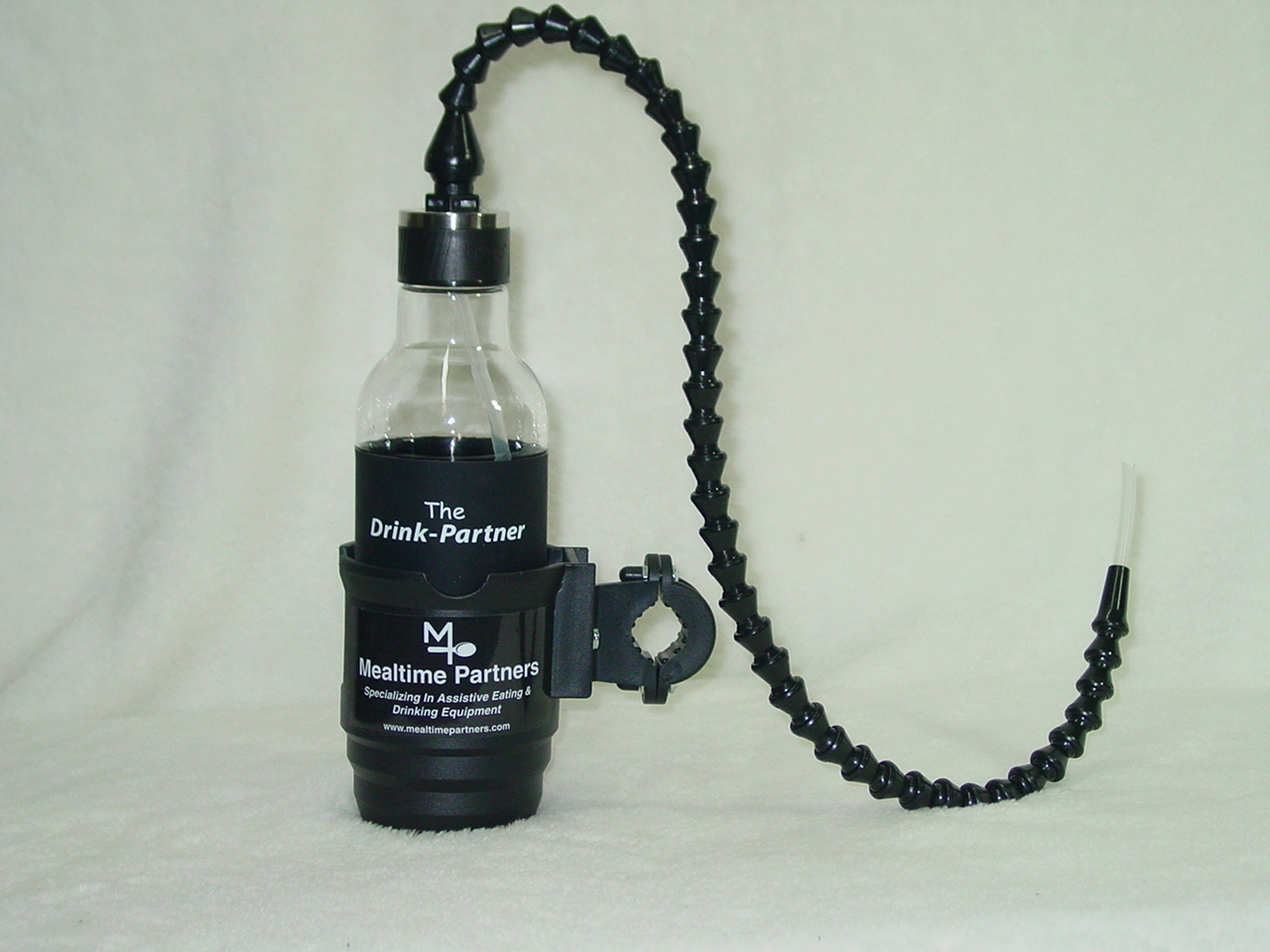 |
| Figure 1: The Drink-Partner Drinking System for Manual Wheelchairs |
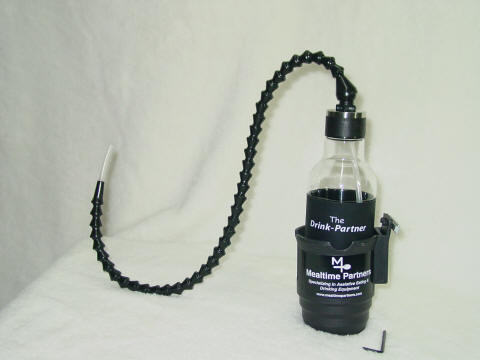 |
| Figure 2: The Drink-Partner Drinking System for Wheelchairs with Slide-Track |
The Drink-Partner shown in Figure 1 can be attached to a wheelchair handle (or frame) by a clamp that is an integral part of the cup holder. The Drink-Partner shown in Figure 2 uses a T-Nut that fits into the slide-track rail to mount it and requires a small tool to tighten it when in position. Many of the newer powered wheelchairs have slide-track rails mounted in many areas of the wheelchair instead of the round tubular frames, providing greater versatility for attaching additional equipment.
Typically, the Drink-Partner Cup Holder is mounted to the back of the wheelchair and the bottle inserted into it. The flex tubing is positioned to guide the drink tube over the user’s shoulder and hold the tip of the drink tube close to the user’s mouth. A typical installation on a manual wheelchair is shown below in Figure 3.
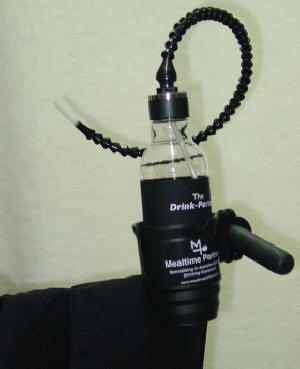 |
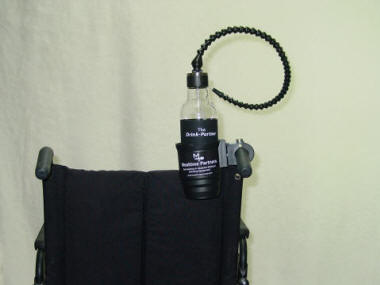 |
| Figure 3: Drink-Partner Mounted on a Manual Wheelchair |
The Drink-Partner bottle (shown in Figure 4) is clear to enable the person using it to see what is in the bottle and how full it is. Additionally, because it is clear, it is easy for the person who cleans it to see that it is truly clean. The lower part of the bottle is covered by an insulated sleeve. The lid on the top of the bottle is a screw cap with a metal cover on its outside. This is important because the metal significantly reduces the possibility of the lid breaking, which is an ongoing problem for bottles that have plastic lids without reinforcement.
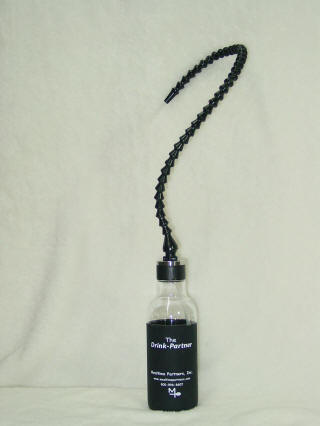 |
| Figure 4: The Drink-Partner Bottle |
Integrated into the Drink-Partner lid is a vibration resistant, 24-inch length of ball and socket tubing (i.e., flex tubing) that holds the drinking tube (i.e., the straw). The ball and socket tubing can be easily reshaped by hand, and allows the end of the drinking tube to be positioned in an accessible location for the user to be able to drink from it with ease. To purchase the Drink-Partner products, click on the selected photograph, above.